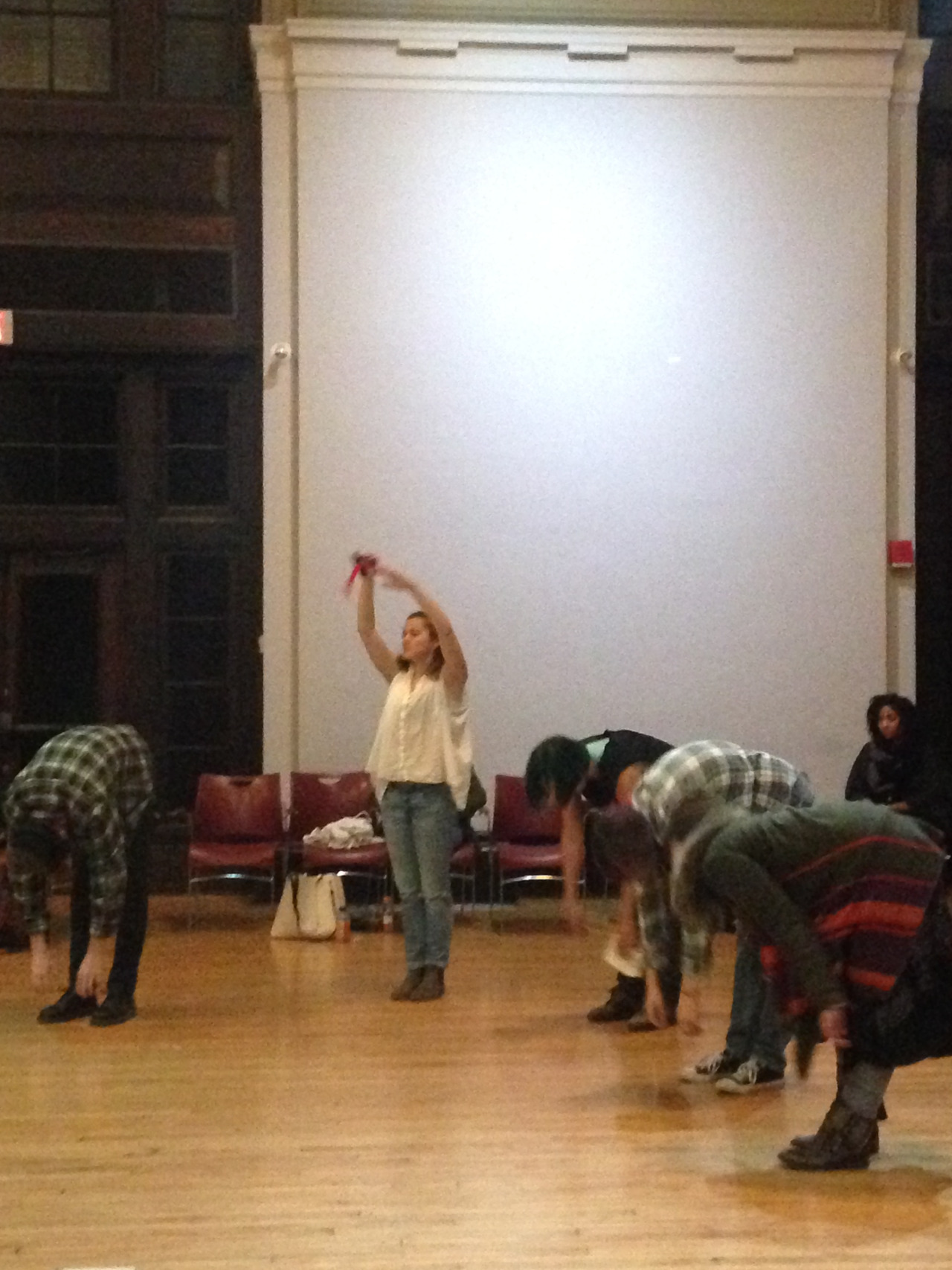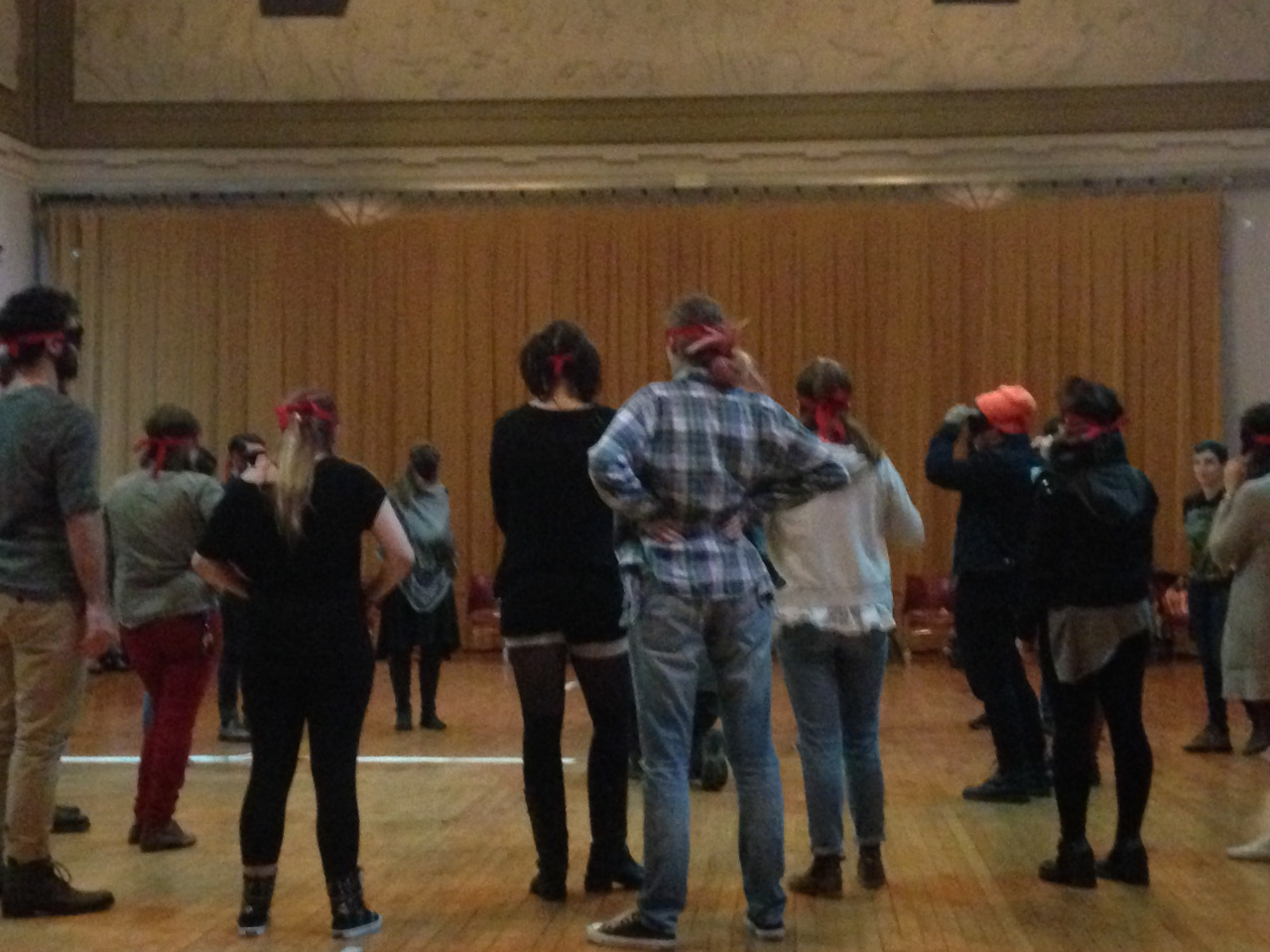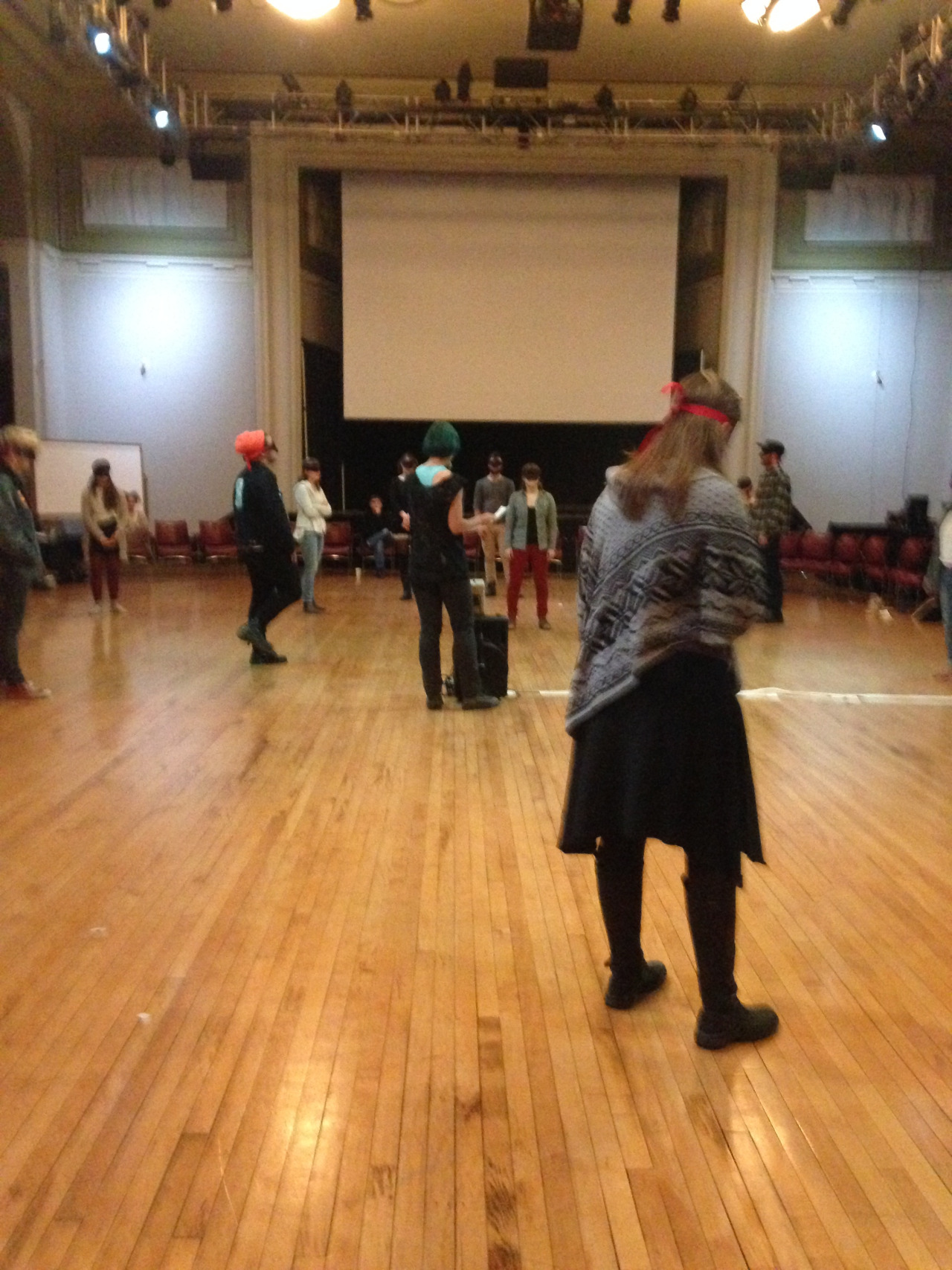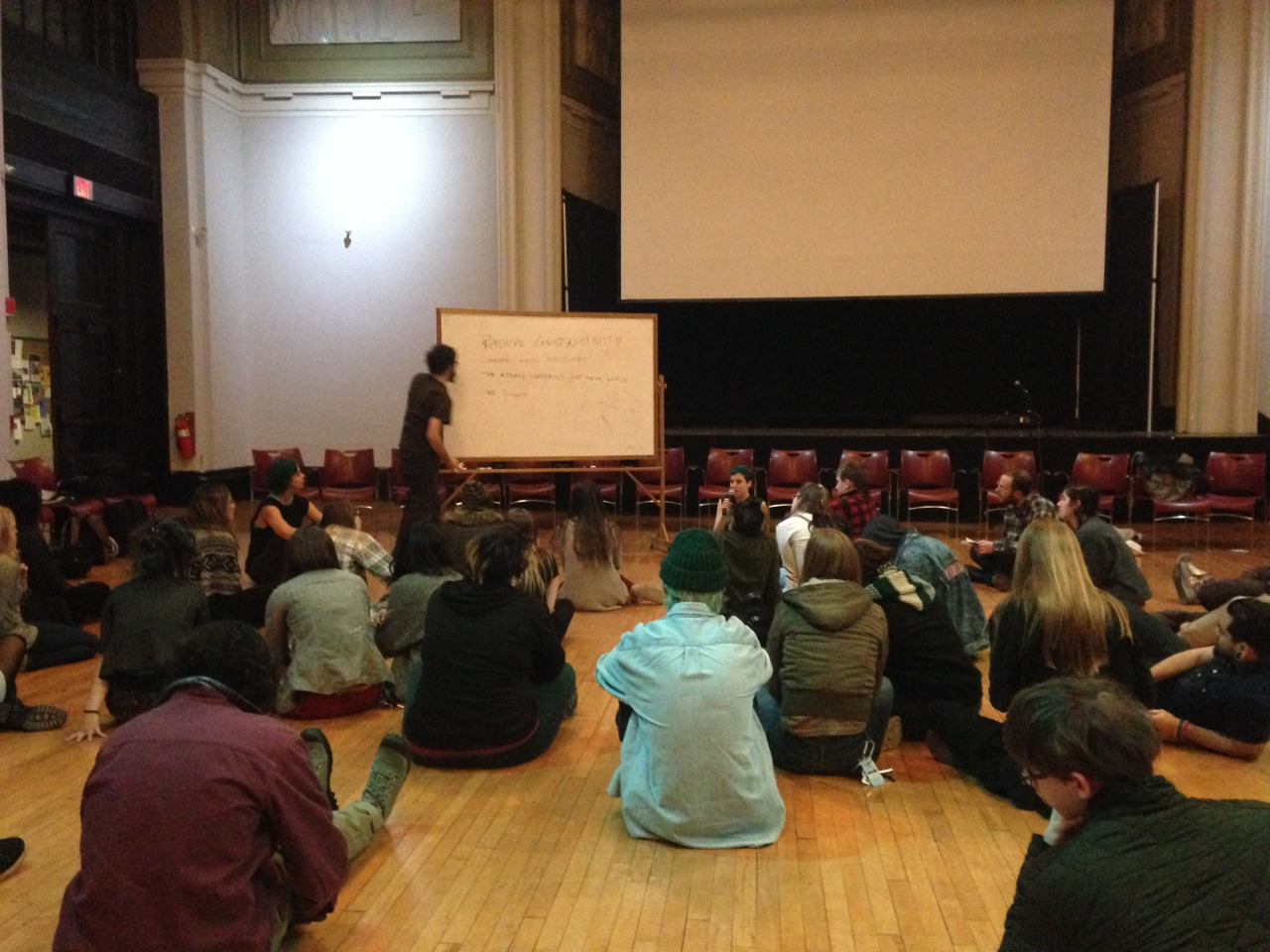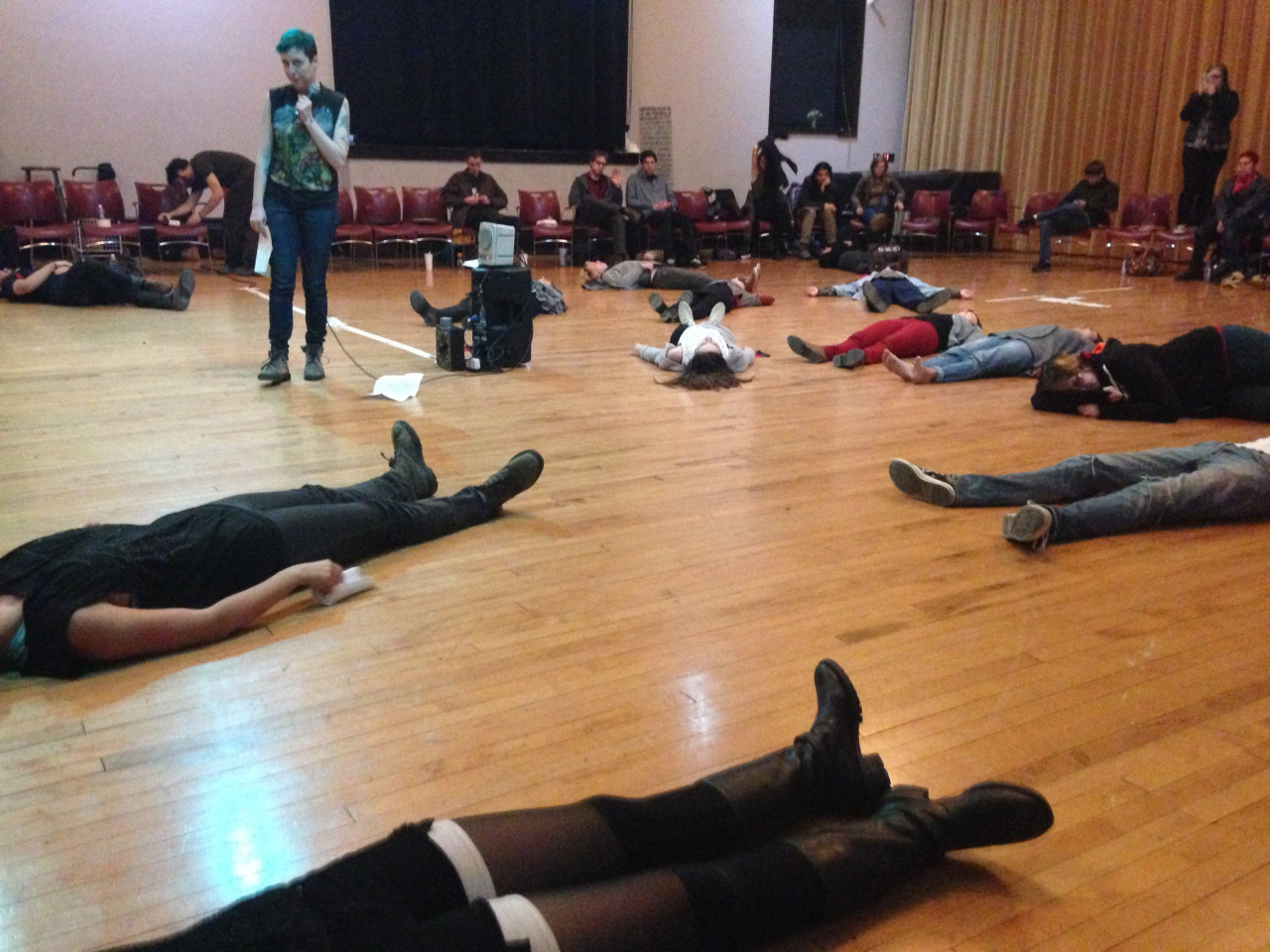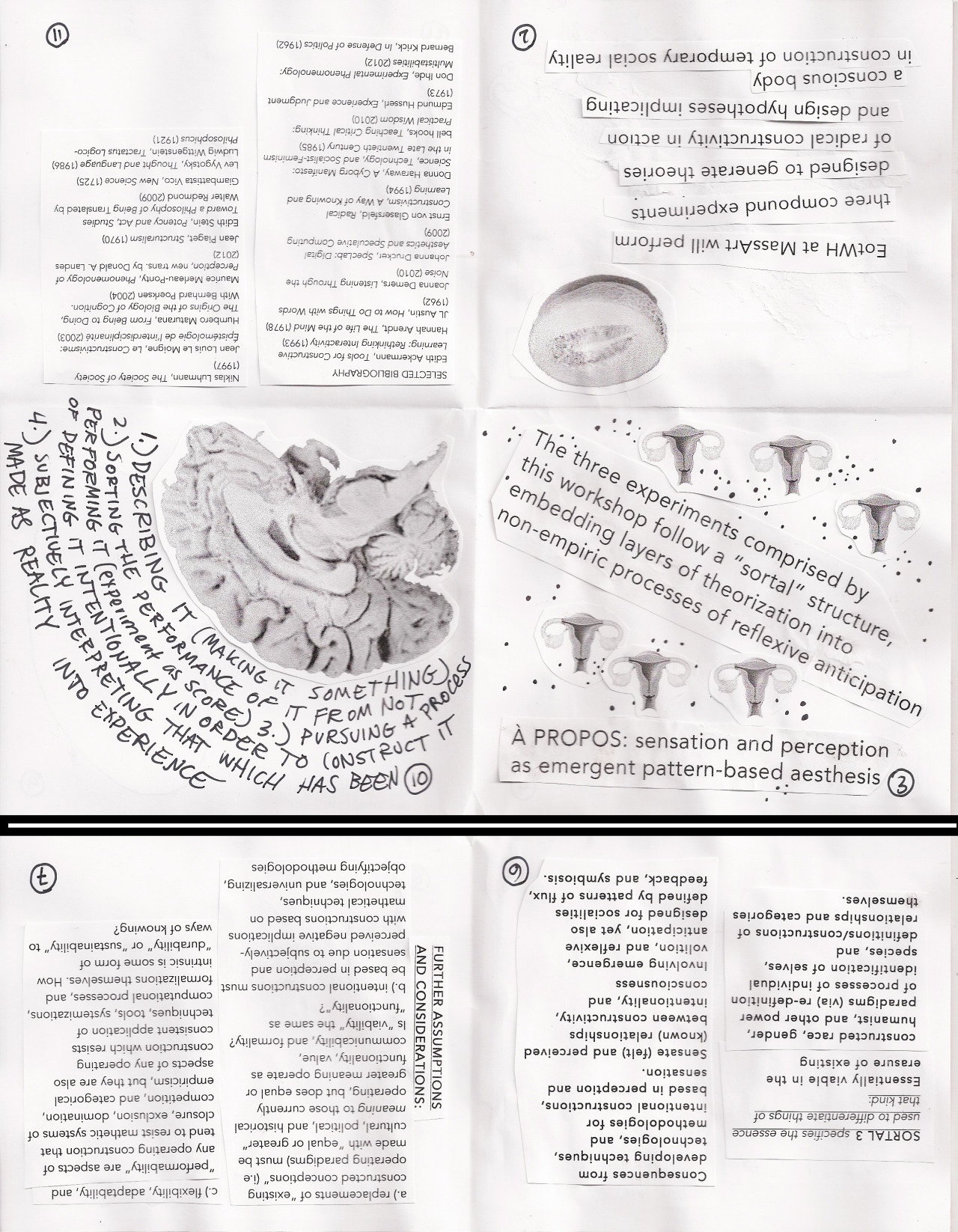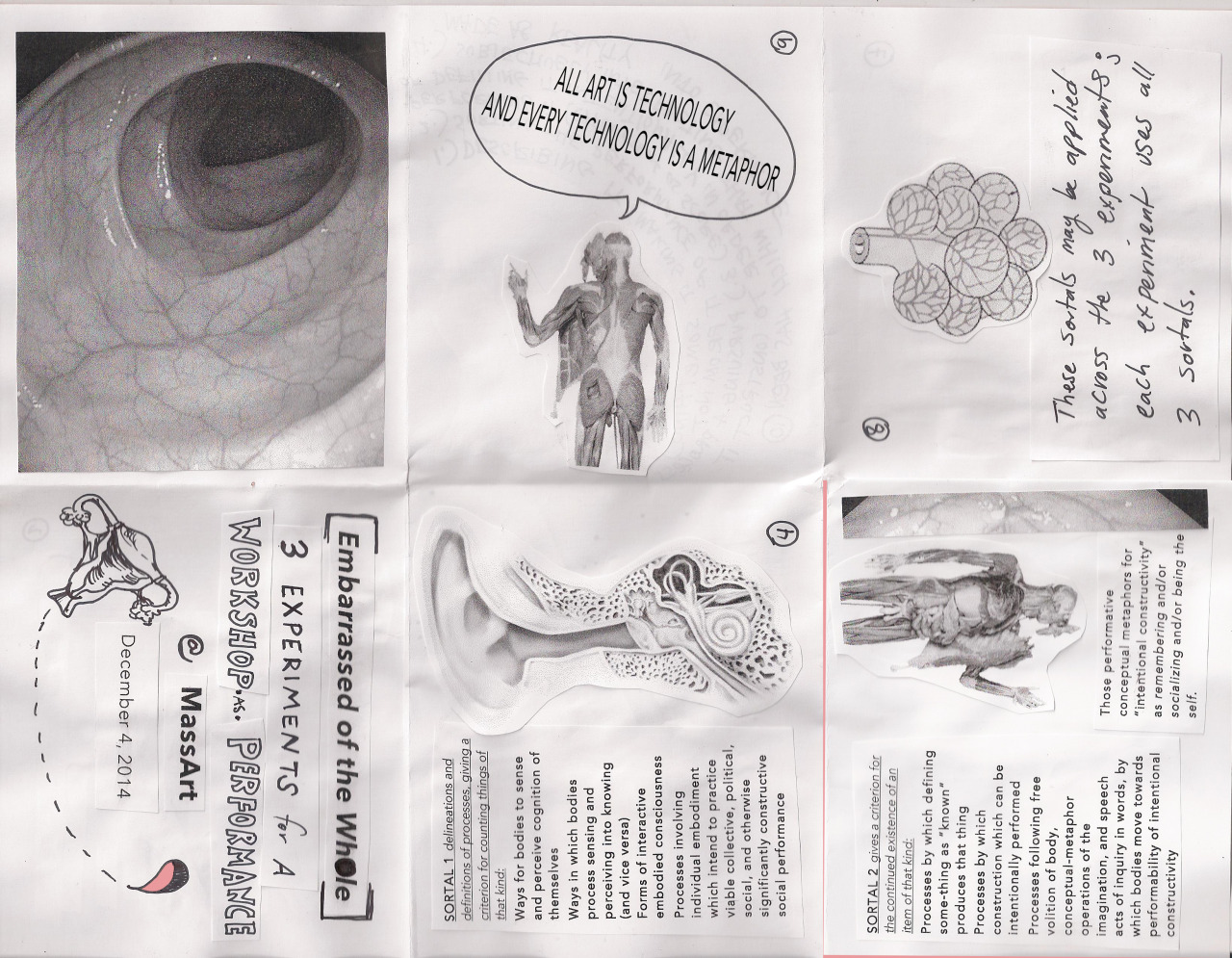Forms include online surveys, quizzes, implicit bias tests, and assessments, as well as live focus groups and lab experiments, each examining processes via which cultural construction and social engineering are performed. This workshop will practice ways in which contextual, subjective input from users can be translated by operators (performers) into operational, constructed output using forms such as "survey" and "score."
Massachusetts College of Art and Design (December 2014) 12/4/2014
SCORE:
SET 3: Pedagogical Somatic Workshop
ALL PARTICIPANTS BLINDFOLDED (Workshop Leader 1)
ALL PARTICIPANTS DEAFENED BY CONSTANT TONE (Workshop Leader 2)
ALL PARTICIPANTS MUST REMAIN PHYSICALLY STILL (Workshop Leader 3)
Needed: blindfolds for all participants
darkroom timer or other timer that produces a timer
The first part of this workshop will be blindfolded
Please tie on your blindfold and find a place in the room to stand
3:1 BLINDFOLDED EXPERIMENTS
Ground your body and feel its parts
Find a part of your body that you can’t feel
you will eventually choose three, but for now focus on one area that is unfelt
drive sound through the part of the body
The part of the body is making this sound
the sound is embodying the part
go through each of three parts to make imaginations of the way they feel
Find one sound for each part of the body that you can’t feel
Rehearse and repeat the three sounds, driving each through its respective unfelt body part
memorize any connectivities or forced relationship between each of the three body parts and respective sounds
repeat until you can repeat the same three sounds by rote,
keep repeating the sounds, begin to listen to the other sounds in the room
Begin to sort different types of the sounds into a three-point pattern in space
move through space, to each area, repeating one of your own sounds that seems most appropriate to the identity of each area
repeat the pattern until all individuals are moving between three areas in the space, each repeating one of their three sounds in each of the areas
repeat the pattern until each area has developed distinction as a category of sound
repeat and reflect until you hear the buzzer
at the buzzer, go back to standing neutrally
3:2 DEAFENED BY CONSTANT TONE EXPERIMENTS
Stand neutrally, keep on your blindfold
feel your body, find a part of your body which is dominant
Let this part of your body take over your body
this part of your body will drive your movement throughout this experiment
this part of your body generates qualities of movement
Practice the generated movement and feeling until it becomes consistent
*REMOVE YOUR BLINDFOLD*
focusing on the dominating part of your body, begin to let it lead you through space
continuing your movement, Look around, and notice other movements, while still moving, practice moving until all of the bodies are moving.
Then begin to sort the types of movement by sight and feeling into three groups in the three areas of the room used before
Find a group which fits your movement, make this group fit your movement
In your group, adapt your own movements to make your group distinct
Don’t lose focus on the dominant body part that is generating your movement
but adapt
When your group is cohesive and distinct, turn your gaze as a group to the other groups
Groups, watch the other groups and make your group as different from the other groups as possible
Continue reactive movement in groups until three distinct forms emerge
individuals may now travel from group to group, each individual taking on, in turn, each group movement, while remaining driven by their own dominating body part
repeat and reflect until the buzzer.
3:3: PHYSICALLY STILL EXPERIMENTS
Get comfortable, preferably lying or sitting on the floor
Feel as much of your body as possible
Do not move, do not so much as scratch or twitch
Imagine that every part of your body has its own way of knowing the world
each part has its own ability to know the world, through sensation and perception
Let your body feel its own sensations and perceptions, let these begin
to become words
Begin to describe the sensations and perceptions of the body, and your sensations and perceptions of it, where can you feel it, where can you see it? where can you only imagine it?
Force the words to become “out loud,” drive air through them and push the sound waves out
Put the words into a question form
Ask questions out loud in a way that they can be heard by everyone in the experiment
Repeat your questions again, reforming it if necessary until you have memorized one question’s exact words and can repeat it out loud by rote
Continue repeating this single sentence, your question, at intervals
begin to listen to the first word of all of the other questions being voiced around you
find the dominant first word in the sentences around you and replace your first word with this word
continue to repeat your question, replacing any words you hear that are repeated, or that seem dominant or otherwise powerful, reforming your own question by replacing individual words
repeat this until everyone is asking the same words
when the same words are being repeated, stand and make a circle, upon eye-contact agreement between experimenters, speak the question in unison.
Proceed with 3:3:
3:3: discussion and analysis in any form
SET 4: Operation Mise-en-abyme experiment
To begin mise en abyme of operative processes, determine an objective for the operation. Take as long as it takes to be as simple and clear as possible: TO….(know myself, perceive auras, find limits of memory, tell a story, deconstruct gender, share experiences, generate solutions to environmental crises, debate physicalism, express anxiety…).
Beneath this objective, write a number of ways in which you will attempt your objective. These relationships should be as formally close as possible: “to learn about microtones” might get “to practice vocalizations repetitively, to experiment with tone rows…”
In order to score how the operation itself is then played by performers, translate verb relationships into structured directives: OPERATIONS.
Take this number of correlated instructions and turn them into directives which are specifically pursuant of at least three operative modes:
Each operation must conscientiously relate to its own definable sphere of conditions, contexts, and anticipated consequences.
Each operation must design its own methodology from which procedural perameters may be delineated.
Each operation must determine its own relationship with, resistance to, or non-association with realities-reinforcement (identification of in-operation realities and [re]presentation of these), realities deconstruction (identification of in-operation realities and resistance, disassociation, or deliberate negation of these), realities construction (deliberative and intentional description and practice “as if” objective realities are coming into being), or fabrication of non-realities (play).
CONCEPTUAL SCORES FOR PROCESSES
Mapping ways (modes) for bodies to sense and perceive cognition of themselves and accounting for some formalization of the affects and consequences of these modes.
Mapping ways (modes) in which bodies process sensing and perceiving into knowing (and vice versa) and accounting for some formalization of the affects and consequences of these modes.
Practicing modes of interactive embodied consciousness which intend themselves as such.
Performing processes involving individual embodiments which intend to practice viable collective, political, social, and otherwise significantly constructive social performance (to “do” something).
Processes by which defining some-thing as “known” produces that thing.
Processes by which construction of a “way of seeing/thinking/feeling” can be intentionally performed.
Processes following free volition of body, conceptual-metaphor operations of the imagination, and speech acts of inquiry in words, by which bodies move towards performability of intentional constructivity.
Processes enabling those performative conceptual metaphors for “intentional constructivity” as remembering and/or socializing and/or being the self.
Mapping that which is seen to be essentially viable in the erasure of existing constructed race, gender, humanist, and other power paradigms (via) re-definition of processes of individual identification of selves, species, and definitions/constructions of relationships, modes, forms, and categories themselves.
Mapping that which is seen/felt/anticipated as consequences of modes for developing techniques, technologies, and methodologies for intentional social constructivity.
FURTHER ASSUMPTIONS AND CONSIDERATIONS:
a.) replacements of “existing constructed conceptions” (i.e operating paradigms) must be made with “equal or greater” cultural, political, and historical “viability” to/than those currently operating, but does equal or greater viability operate as functionality, value, communicability, and formality? Is “viability” the same as “use-value”?
INQUIRY SCORES:
a.) 2 performers each make a list of six objects written-in by users
b.) each performer describes the object’s use (function) without naming the object
c.) the other performer uses the absent unknown object
